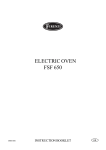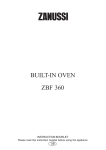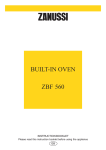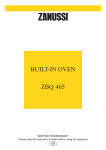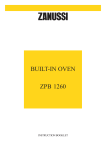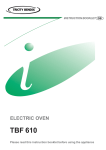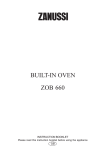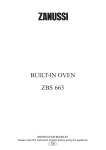Download Electrolux U26226 User's Manual
Transcript
Electric built-in oven INSTR UCTION INSTRUCTION BOOKLET Please read this instruction booklet before using the appliance Models ESOMBR - ESOMWH - ESOMSS 35687-5701 GB Important Safety Information You MUST read these warnings carefully before installing or using the oven. If you need assistance, contact our Customer Care Department on 08705 950950 Installation • This oven must be installed by qualified personnel to the relevant British Standards. • Ensure that all control knobs are in the OFF position when not in use. • This oven is heavy. Take care when moving it. • • Remove all packaging, both inside and outside the oven, before using the oven. Do not leave cookware containing foodstuffs, e.g. fat or oil in or on the oven in case it is inadvertently switched ON. • Do not attempt to modify the oven in any way. • When using other electrical appliances, ensure the cable does not come into contact with the hot surfaces of the oven. Child Safety • This oven is designed to be operated by adults. Do not allow children to play near or with the oven. • The oven gets hot when it is in use. Children should be kept away until it has cooled. • This appliance is not intended for use by children or other persons whose physical, sensory or mental capabilities or lack of experience and knowledge prevents them from using the appliance safely without supervision or instruction by a responsible person to ensure that they can use the appliance safely. During Use • This oven is intended for domestic cooking only. It is not designed for commercial or industrial purposes. • Appliances become very hot with use, and retain their heat for long periods after use. Care should be taken to avoid touching heating elements inside the oven. • Always stand back from the oven when opening the oven door during cooking or at the end of it to allow any build up of steam or heat to release. • Never line any part of the oven with aluminium foil. • Do not allow heatproof cooking material, e.g. roasting bags, to come into contact with oven elements. • Never place plastic or any other material which may melt in or on the oven. • Do not place sealed cans or aerosols inside the oven. They may explode if they are heated. • Do not hang towels, dishcloths or clothes from the oven or its handle. • Do not use this oven if it is in contact with water and never operate it with wet hands. • Take great care when heating fats and oils as they will ignite if they become too hot. • Always use oven gloves to remove and replace food in the oven. 2 Maintenance and Cleaning • Only clean this oven in accordance with the instructions. • The oven should be kept clean at all times. A build-up of fats or other foodstuffs could result in a fire, especially in the grill pan. • Never use steam or high pressure steam cleaners to clean the appliance. • Always allow the oven to cool down and switch off the electrical supply before carrying out any cleaning or maintenance work. Service • This oven should only be repaired or serviced by an authorised Service Engineer and only genuine approved spare parts should be used. Environmental Information • After installation, please dispose of the packaging with due regard to safety and the environment. • When disposing of an old appliance make it unusable by cutting off the cable. Remove any door catches to prevent small children being trapped inside. on the product or on its packaging The symbol indicates that this product may not be treated as household waste. Instead it shall be handed over to the applicable collection point for the recycling of electrical and electronic equipment. By ensuring this product is disposed of correctly, you will help prevent potential negative consequences for the environment and human health, which could otherwise be caused by inappropriate waste handling of this product. For more detailed information about recycling of this product, please contact your local city office, your household waste disposal service or the shop where you purchased the product. Contents For the User For the Installer Important Safety Information 2 Installation 18 Description of the Oven 4 Technical Data 18 Controls 5 Electrical Connection 18 Before the First Use 6 Building In 19 Electronic Programmer 7 Using the Oven 9 Hints and Tips 9 The Fan Oven 10 Cooking Chart - Fan Oven 11 Grilling 12 Defrosting 13 Cleaning the Oven 14 Replacing the Oven Light 15 Something not Working 15 Service and Spare Parts 16 Guarantee Conditions 16 European Guarantee 17 Guide to use the instructions The following symbols will be found in the text to guide you throughout the Instructions: Safety Instructions ) Step by step instructions for an operation Hints and Tips Environmental information This appliance complies with the following E.E.C. Directives: *2006/95 (Low VoltageDirective); *93/68 (General Directives); *89/336 (Electromagnetical Compatibility Directive) and subsequent modifications. Keep this instruction book for future reference and ensure it is passed on to any new owner. 3 Description of the Oven 6 5 4 3 2 1 8 7 9 10 1. Control panel 6. Thermostat Control Light 2. Oven Control Function Knob 7. Oven Light 3. Electronic Programmer 8. Grill 4. Thermostat Control Knob 9. Oven Fan 5. Mains on Light 10.Rating Plate Oven accessories Removable handle Grill Pan Grid Anti-tip shelf (x 2) Grill / Roasting pan 4 Controls Oven Function Control Knob 0 The oven is off Oven light - The oven light will be on without any cooking function Inner grill element only - Can be used for grilling small quantities Full Grill - The full grill element will be on. Recommended for large quantities. Thermal Grilling - This function offers an alternative method of cooking food items, normally associated with conventional grilling. The grill element and the oven fan operate together, circulating hot air around the food. Fan cooking - This allows you to roast or roast and bake simoultaneously using any shelf, without flavour transference Defrost Setting - This setting is intended to assist in thawing of frozen food. Thermostat Control Knob (°C) Turn the thermostat control knob clockwise to select temperatures between 50 °C and 230 °C (MAX). Thermostat Control Light The thermostat control light will come on when the thermostat control knob is turned. The light will remain on until the correct temperature is reached. It will then cycle on and off to show the temperature is being maintained. Mains on Light The mains on light will come on when the oven function control knob is set. The Safety Thermostat This oven is provided with a safety thermostat. In case of malfunctioning of the main thermostat, and consequential over-heating, the safety device will stop the power supply to the appliance. If this happens, call your local Service Force Centre. Under no circumstances should you attempt to repair the appliance yourself. 5 The cooling fan The cooling fan operates during cooking. Air is expelled through vents between the oven door and the control panel, as shown in the diagram. The cooling fan may run on after the oven is switched off to keep the controls cool. This is quite normal. Before the First Use Remove all packaging, both inside and outside the oven, before using the oven. Before first use, the oven should be heated without food. During this time, an unpleasant odour may be emitted. This is quite normal. The oven will work only if the time of day has been set. 1. Set the time of day with the electronic programmer (see chapter "Electronic Programmer"). 2. Switch the oven function control knob to fan ) cooking . 3. Set the thermostat control knob to MAX. 4. Open a window for ventilation. 5. Allow the oven to run empty for approximately 45 minutes. This procedure should be repeated with the full grill function for approximately 5-10 minutes. 6 Electronic Programmer 4 1. Push button for selecting a function 5 6 7 8 2. Decreasing control button “ ” 3. Increasing control button “ ” 4. Display 5. “Cooking Duration” pilot lamp 6. “End of cooking” pilot lamp 2 1 3 7. “Minute minder” pilot lamp 8. “Time of day” pilot lamp The oven will only work if the time of day has been set. However, the oven can also be operated without any programme. Setting the time of day When the power supply is switched on, or after a power failure, the “Time of day” pilot lamp will flash on the display. To set the correct time of day: 1. Press button “ ” or “ ”. 2. After the setting is carried out, wait for 5 seconds: the “Time of day” pilot lamp will go out and the display will show the set time. The appliance is ready for use. To reset the correct time of day: 1. Press button repeatedly to select the “Time of day” function. The relevant pilot lamp will start flashing. Then proceed as described above. The time of day can only be reset if no automatic function (cook duration or end of cooking ) has been set. “Cooking Duration” function This function allows the oven to automatically switch off at the end of a programmed cooking duration time. Place food in the oven, select a cooking function and adjust the cooking temperature. Press button repeatedly to select the “Cooking Duration” function. The relevant pilot lamp will start flashing. Then, proceed as follows: To set the duration time: 1. Press button “ ” or “ ”. 2. After the setting is carried out, wait for 5 seconds: the "Cooking Duration" pilot lamp will come on and the display will revert to the time of day. 3. When cooking time is over, the oven will be switched off automatically and an acoustic alarm will be heard, while the pilot lamp will start flashing. Turn the oven function and the thermostat control knob to zero. To switch off the acoustic alarm, press any button. NOTE: turning the acoustic alarm off will reset the oven to manual, and if the oven function and the thermostat knobs are not set to zero the oven will start to heat again. To cancel the duration time: 1. Press button repeatedly to select the “Cooking Duration” function. The relevant pilot lamp will flash and the display will show the remaining cooking time. 2. Press button “ ” until the display shows “0:00”. After 5 seconds the pilot lamp will go out and the display will revert to the time of day. 7 “End of cooking” function With this function, you can set the oven to switch off automatically when a programmed end of cooking time is over. Place food in the oven, select a cooking function and adjust the cooking temperature. Press button repeatedly to select the “End of cooking” function. The relevant pilot lamp will start flashing. Then, proceed as follows: To set the End of cooking time: 1. Press button “ ” or “ ”. 2. After the setting is carried out, wait for 5 seconds: the “End of cooking” pilot lamp will come on and the display will revert to the time of day. 3. When cooking time is over, the oven will be switched off automatically and an acoustic alarm will be heard, and the pilot lamp will start flashing. Turn the oven function and the thermostat control knob to zero. To switch off the acoustic alarm, press any button. NOTE: turning the acoustic alarm off will reset the oven to manual, and if the oven function and the thermostat knobs are not set to zero the oven will start to heat again. To cancel the End of cooking time: repeatedly to select the “End of cooking” function. The 1. Press button will flash and the display will show the programmed relevant pilot lamp End of cooking time. 2. Press button “ ” until the display shows the current time of day. The programmer will beep and the pilot lamp will go out. “Cooking duration” time” combined and “End of cooking The functions “Cooking duration” and “End of cooking time” can be used simultaneously to set the oven to switch on and off automatically at a later time. 1. With the “Cooking duration” function (carry out the cooking duration setting as described in the relevant chapter) set the duration time. Then, press button : the display will show the programmed setting. 2. With the “End of cooking time” function (carry out the End of cooking setting as described in the relevant chapter) set the end of cooking time. The relevant pilot lamps will come on and the display will show the time of day. The oven will switch on and off according to the set programmes. “Minute minder” function The minute minder alarm will sound at the end of a timed period, but THE OVEN WILL REMAIN ON, if it is in use. To set the minute minder: 1. Press button repeatedly to select the “Minute minder” function. The relevant pilot lamp will start flashing. 2. Then, press button “ ” or “ ” (maximum: 2 hours, 30 minutes). 3. After the setting is carried out, wait for 5 seconds: the “Minute minder” pilot lamp will come on. 4. At the end of the timed period, the pilot lamp will start flashing and an acoustic alarm will be heard. To switch off the acoustic alarm, press any button. To cancel the minute minder: 1. Press button repeatedly to select the “Minute minder” function. The relevant pilot lamp will flash and the display will show the remaining time. 2. Press button “ ” until the display shows “0:00”. After 5 seconds the pilot lamp will go out and the display will revert to the time of day. How to switch off the display 1. Press two or three programmer push buttons simoultaneously and keep them pressed for about 5 seconds. The display will switch off. 2. To switch on the display, press any button. The display can be switched off only if no other functions have been set. 8 Using the Oven Always cook with the oven door closed. Stand clear when opening the drop down oven door. Do not allow it to fall open - support the door using the door handle, until it is fully open. The oven has four shelf levels, and is supplied with two shelves. The shelf positions are counted from the bottom of the oven as shown in the diagram. It is important that these shelves are correctly positioned as shown in the diagram. Do not place cookware directly on the oven base. 4 3 2 1 Attention! - Do not place objects on the oven base and do not cover any part of the oven with aluminium foil while cooking, as this could cause a heat build-up which would affect the baking results and damage the oven enamel. Always place pans, heat-resisting pans and aluminium trays on the shelf which has been inserted in the shelf runners. Hints and Tips Condensation and Steam The oven is supplied with an exclusive system which produces a natural circulation of air and the constant recycling of steam. This system makes it possible to cook in a steamy environment and keep the dishes soft inside and crusty outside. Moreover, the cooking time and energy consumption are reduced to a minimum. During cooking steam may be produced which can be released when opening the oven door. This is absolutely normal. However, always stand back from the oven when opening the oven door during cooking or at the end of it to allow any build up of steam or heat to release. If the steam comes into contact with a cool surface on the outside of the oven, e.g. a trim, it will condense and produce water droplets. This is quite normal and is not a fault with the oven. To prevent discolouration, regularly wipe away condensation and also soilage from surfaces. The effects of dishes on cooking results Dishes and tins vary in their thickness, conductivity, colour, etc. which affects the way they transmit heat to the food inside them. A Aluminium, earthenware, oven glassware and bright shiny utensils reduce cooking and base browning. B Enamelled cast iron, anodized aluminium, aluminium with non-stick interior and coloured exterior and dark, heavy utensils increase cooking and base browning. Cookware • • • Use any oven proof cookware which will withstand temperatures of 230 °C. Baking trays, oven dishes, etc. should not be placed directly against the grid covering the fan at the back of the oven, or placed on the oven base. Do not use baking trays larger than 30 cm x 35 cm (12 in x 14 in) as they will restrict the circulation of heat and may affect performance. 9 The Fan Oven The air inside the oven is heated by the element around the fan situated behind the back panel. The fan circulates hot air to maintain an even temperature inside the oven. The advantage of cooking with this function is energy saving through: z Faster Preheating As the fan oven quickly reaches temperature, it is not usually necessary to preheat the oven although you may find that you need to allow an extra 5-7 minutes on cooking times. For recipes which require higher temperatures, best results are achieved if the oven is preheated first, e.g. bread, pastries, scones, souffles, etc. z Lower Temperatures Fan oven cooking generally requires lower temperatures than conventional cooking. Follow the temperatures recommended in the cooking chart. Remember to reduce temperatures by about 20-25°C for your own recipes which use conventional cooking. z Even Heating for Baking The fan oven has uniform heating on all shelf positions. This means that batches of the same food can be cooked in the oven at the same time. However, the top shelf may brown slightly quicker than the lower one. This is quite usual. There is no mixing of flavours between dishes. Hints and Tips - Shelf positions are not critical, but make sure the shelves are evenly spaced. - When cooking more than one dish in the fan oven, place dishes centrally on the shelves rather than several dishes on one shelf. - When the oven is full, you may need to allow slightly longer cooking time. - When the oven is full of the same food, e.g. equal trays of small cakes or equal size victoria sandwich cakes, then they will be cooked in the same time and removed from the oven together. When different sizes of trays or types of food, e.g. biscuits and cakes are cooked, they will not necessarily be ready together. - The fan oven can be used to heat foods through without thawing first, e.g. fruit tarts, mince pies, sausage rolls, and other small pastry items. Use a temperature of 190-200°C and allow 20-40 minutes (depending on the quantity of food in the oven). - The use of too high temperatures can cause uneven browning. Check with the recommendations for oven temperatures given in the cooking charts, but be prepared to adjust the temperature, if necessary. Remember to reduce temperatures by about 20-25°C for your own conventional recipes. - When roasting do use the trivet in the meat tin. Fat and meat juices will drain into the meat tin below and can be used to make gravy. The trivet also prevents splashes of fat from soiling the oven interior. - The meat tin should not be placed on a heated hotplate as this may cause the enamel to crack. ) How to use the Fan Oven 1. Turn the oven function control knob to . 2. Turn the thermostat control to the required temperature. Things to note • • • The oven light will come on when the oven function control knob is set. The oven fan will operate continually during cooking. The thermostat control light will remain on until the correct temperature is reached. It will then cycle on and off to show the temperature is being maintained. The cooling fan During cooking the cooling fan will operate continually. It may run on after the oven is switched off to keep the controls cool. This is quite normal. NOTE The action of the cooling fan will depend on how long the oven has been used and at what temperature. It may not switch in at all at lower temperature settings nor run on where the oven has only been used for a short time. 10 Weight (gr.) Cooking Chart- Fan Oven 1000 500 500 250 1000 1200 1000 1500 1500 1500 1500 2000 1200 1200 1000 4000 1500 3000 1200 1500 800 1200 1500 Level 4 3 2 1 TYPE OF DISH cooking temperature (°C) Cooking time NOTES minutes CAKES Whisked recipes Shortbread dough Butter-milk cheese cake Apple cake Strudel Jam-tart Fruit cake Sponge cake Christmas cake Plum cake Small cakes Biscuits Meringues Buns Pastry: Choux BREAD AND PIZZA White bread Rye bread Bread rolls Pizza FLANS Pasta flan Vegetable flan Quiches Lasagne Cannelloni MEAT Beef Pork Veal English roast beef rare medium well done Shoulder of pork Shin of pork Lamb Chicken Turkey Duck Goose Rabbit Hare Pheasant Meat loaf FISH Trout/Sea bream Tuna fish/Salmon 2 (1 and 3)* 2 (1 and 3)* 2 2 (1 and 3)* 2 2 (1 and 3)* 1 2 (1 and 3)* 1 1 2 (1 and 3)* 2 (1 and 3)* 2 (1 and 3)* 2 (1 and 3)* 2 (1 and 3)* 160 160 150 170 150 160 160 160 160 160 160 150 100 180 190 45 ~ 60 20 ~ 30 60 ~ 80 40 ~ 60 60 ~ 80 30 ~ 40 45 ~ 60 30 ~ 40 40 ~ 60 50 ~ 60 25 ~ 35 20 ~ 30 90 ~ 120 12 ~ 20 15 ~ 25 In cake mould In cake mould In cake mould In cake mould In bread tin In cake mould In cake mould In bread pan In baking tray In baking tray In baking tray In baking tray In baking tray 2 1 2 (1 and 3)* 2 (1 and 3)* 180 180 175 190 40 ~ 60 30 ~ 45 20 ~ 35 15 ~ 30 1-2 pieces In bread tin 6-8 rolls on baking tray 2 (1 and 3)* 2 (1 and 3)* 2 (1 and 3)* 2 2 175 175 180 160 175 40 ~ 50 45 ~ 60 35 ~ 45 45 ~ 60 40 ~ 55 in mould in mould in mould in mould in mould 2 2 2 175 175 175 50 ~ 70 100 ~ 130 90 ~ 120 On grid On grid On grid 2 2 2 2 2 2 2 2 2 2 2 2 2 2 200 200 200 170 160 175 175 160 160 160 175 175 175 160 50 ~ 60 60 ~ 70 70 ~ 80 120 ~ 150 100 ~ 120 110 ~ 130 60 ~ 80 210 ~ 240 120 ~ 150 150 ~ 200 60 ~ 80 150 ~ 200 90 ~ 120 40 ~ 60 On grid On grid On grid With rind 2 pieces Leg Whole Whole Whole Whole Cut in pieces Cut in pieces Whole in bread pan 2 (1 and 3)* 2 (1 and 3)* 175 175 30 ~ 40 25 ~ 35 3-4 fishes 4-6 fillets This chart is intended as a guide only. It may be necessary to increase or decrease the temperature to suit your individual requirements. Only experience will enable you to determine the correct setting for your personal requirements. NOTE: Shelf positions are counted from bottom of the oven. We recommend to pre-heat the oven for about 10 minutes before cooking. 11 Grilling Grilling must be carried out with the oven door closed. The grill pan handles must be removed from the pan during grilling. Always use oven gloves to remove and replace the grill pan handles. Ensure that you support the grill pan when removing it from the oven. ) How to Use the Full Grill 1. Turn the oven control function knob on . 2. Turn the thermostat control knob on the required temperature. 3. Adjust the grid and grill pan runner position to allow for different thicknesses of food. Position the food close to the element for faster cooking and further away for more gentle cooking. Preheat the grill on a full setting for a few minutes before sealing steaks or toasting. Adjust the heat setting and the shelf as necessary, during cooking. During cooking, the cooling fan and the thermostat control light will operate in the same way as described for the fan oven function. Hints and Tips - - - Most foods should be placed on the grid in the grill pan to allow maximum circulation of air and to lift the food out of the fats and juices. Food such as fish, liver and kidneys may be placed directly on the grill pan, if preferred. Food should be thoroughly dried before grilling to minimise splashing. Brush lean meats and fish lightly with a little oil or melted butter to keep them moist during cooking. Accompaniments such as tomatoes and mushrooms may be placed underneath the grid when grilling meats When toasting bread, we suggest that the top runner position is used. The food should be turned over during cooking, as required. The grill element is controlled by the thermostat. During cooking, the grill cycles on and off to prevent overheating. ) How to Use the Inner Grill Element The inner grill provides quick direct heat to the central area of the grill pan. By using the inner grill element for cooking small quantities, it can help to save energy. 1. Turn the oven control function knob on . 2. Turn the thermostat control knob on the required temperature. 3. Adjust the grid and grill pan runner position to allow for different thicknesses of food and follow the instructions for grilling. Cooking chart - Grilling OI L - Quantity Level TYPE OF DISH Fillet steaks Beef-steaks Sausages Pork chops Chicken (cut in two) Kebabs Chicken (breast) Hamburger Fish (fillets) Sandwiches Toast Pieces Weight 4 4 8 4 2 4 4 6 4 4-6 4-6 800 600 — 600 1000 — 400 600 400 — — 4 3 2 1 3 3 3 3 3 3 3 3 3 3 3 Temperature °C Upper side 250 250 250 250 250 250 250 250 250 250 250 12 ~ 15 10 ~ 12 12 ~ 15 12 ~ 16 30 ~ 35 10 ~ 15 12 ~ 15 10 ~ 15 12 ~ 14 3~7 2~4 The chart is intended as a guide only and should be adjusted according to taste. Cooking time depends on the thickness of the meat and not on its weight. 12 Cooking time (minutes) Lower side 12 ~ 14 6~8 10 ~ 12 12 ~ 14 25 ~ 30 10 ~ 12 12 ~ 14 8 ~ 10 10 ~ 12 — 2~3 ) How to Use the Thermal Grill Hints and Tips Thermal grilling offers an alternative method of cooking food items normally associated with conventional grilling. The grill element and the oven fan operate alternately, circulating hot air around the food. The need to check and turn the food is reduced. Thermal grilling helps to minimize cooking smells in the kitchen. With the exception of toast and rare steaks, you can thermally grill all the foods you would normally cook under a conventional grill. Cooking is more gentle, therefore food generally takes a little longer to cook with thermal grilling compared with conventional grilling. One of the advantages is that larger quantities can be cooked at the same time. Prepare foods in the same way as for conventional grilling. Brush lean meats and fish lightly with a little oil or butter to keep them moist during cooking. 1. Turn the oven control function knob on . 2. Turn the thermostat control knob on the required temperature. Select a maximum temperature of 200°C 3. Adjust the grid and grill pan runner position to allow for different thicknesses of food and follow the instructions for grilling. Cooking chart - Thermal grilling When using the thermal grill cooking function, select a maximum temperature of 200°C. TYPE OF DISH Level Quantity (gr.) Rolled joints (turkey) Chicken (cut in two) Chicken legs Quail Vegetable gratin St. Jacques shells Mackerel Fish slices Temperature 4 3 2 1 1000 1000 — 500 — — — 800 3 3 3 2 3 3 3 3 Time in minutes °C lower side upper side 200 200 200 200 200 200 200 200 30 ~ 40 25 ~ 30 15 ~ 20 25 ~ 30 20 ~ 25 15 ~ 20 15 ~ 20 12 ~ 15 20 ~ 30 20 ~ 30 15 ~ 18 20 ~ 25 — — 10 ~ 15 8 ~ 10 Defrosting The oven fan operates without heat and circulates the air, at room temperature, inside the oven. This increases the speed of defrosting. However, please note that the temperature of the kitchen will influence the speed of defrosting. This function is particularly suitable for delicate food which could be damaged by heat, e.g. cream filled gateaux, iced cakes, pastries, bread and other yeast products. ) How to Use Defrosting 1. Turn the oven function control knob to Hints and Tips • • • • . Cover food with a lid, aluminium foil or plastic film to prevent drying out during defrosting. ALWAYS COOK THOROUGHLY IMMEDIATELY AFTER THAWING. Frozen food should be placed in a single layer when ever possible and turned over half way through the defrosting process. Only joints of meat and poultry up to 2 kg. (4 lb.) are suitable for defrosting in this way. 2. Ensure the thermostat control knob is in the OFF position. 13 Cleaning the Oven Before cleaning always allow the cooling fan to cool the oven down before switching off at the electricity supply. This appliance cannot be cleaned with steam or with a steam cleaning machine. The oven should be kept clean at all times. A build-up of fats or other foodstuffs could result in a fire, especially in the grill pan. Cleaning materials Before using any cleaning materials on your oven, check that they are suitable and that their use is recommended by the manufacturer. Cleaners that contain bleach should NOT be used as they may dull the surface finishes. Harsh abrasives should also be avoided. External cleaning Regularly wipe over the control panel, oven door and door seal using a soft cloth well wrung out in warm water to which a little mild washing-up liquid has been added. To prevent damaging or weakening the door glass panels avoid the use of the following: • Household detergent and bleaches • Impregnated pads unsuitable for non-stick saucepans • Brillo/Ajax pads or steel wool pads • Chemical oven pads or aerosols • Rust removers • Bath/Sink stain removers Clean the outer and inner door glass using warm soapy water. Should the inner door glass become heavily soiled it is recommended that a cleaning product such as Hob Brite is used. Do not use paint scrapers to remove soilage. DO NOT clean the oven door while the glass panels are warm. If this precaution is not observed the glass panel may shatter. If the door glass panel becomes chipped or has deep scratches, the glass will be weakened and must be replaced to prevent the possibility of the panel shattering. Contact your local Service Force Centre who will be pleased to advise further. Oven Cavity The enamelled oven cavity is best cleaned whilst the oven is still warm. Wipe the oven over with a soft cloth soaked in warm soapy water after each use. From time to time it will be necessary to do a more thorough cleaning, using a proprietary oven cleaner. Oven Shelves To clean the oven shelves, soak in warm soapy water and remove stubborn marks with a well wetted soap impregnated pad. Rinse well and dry with a soft cloth. 14 Replacing the Oven Light Disconnect the appliance from the power supply. If the oven bulb needs replacing, it must comply with the following specifications: - Electric power: 15 W, - Electric rate: 230 V (50 Hz), - Resistant to temperatures of 300 °C, - Connection type: E14. These bulbs are available from your local Service Force Centre. To replace the faulty bulb: 1. Ensure the oven is disconnected from the electrical supply. 2. Turn the glass cover anticlockwise. 3. Remove the faulty bulb and replace with the new one. 4. Refit the glass cover. 5. Reconnect to the electrical supply. ) Something not working If the oven is not working correctly, please carry out the following checks, before contacting your local Service Centre. IMPORTANT: If you call out an engineer to a fault listed below, or to repair a fault caused by incorrect use or installation, a charge will be made even if the appliance is under guarantee. SYMPTOM The oven does not come on SOLUTION Check that the current time of day has been set on the programmer (see chapter "Setting the time of day") Check that both a cooking function and temperature have been selected. Check the oven is wired in properly, and the socket switch or the switch from the mains supply to the oven are ON. The oven temperature light does not come on Select a temperature with the thermostat control knob Select a function with the oven function control knob. The oven light does not come on Select a function with the oven function control knob Check the light bulb, and replace it if necessary (see "Replacing the Oven Light") It takes too long to finish the dishes, or they are cooked too fast. Steam and condensation settle on the food and the The temperature may need adjusting Refer to the contents of this booklet, especially to the chapter “Using the Oven”. oven cavity. Leave dishes inside the oven no longer than 15-20 minutes after the cooking is completed. The electronic programmer does not work Check the instructions for the timer. The oven fan is noisy Check that shelves and bakeware are not vibrating in contact with the oven back panel. 15 Guarantee Conditions Standard Guarantee Conditions We, Electrolux, undertake that if within 12 months of the date of the purchase this Electrolux appliance or any part thereof is proved to be defective by reason only of faulty workmanship or materials, we will, at our option repair or replace the same FREE OF CHARGE for labour, materials or carriage on condition that: •The appliance has been correctly installed and used only on the gas and electricity supply stated on the rating plate. •The appliance has been used for normal domestic purposes only, and in accordance with the manufacturer’s instructions. •The appliance has not been serviced, maintained, repaired, taken apart or tampered with by any person not authorised by us. •Electrolux Service Force Centre must undertake all service work under this guarantee. •Any appliance or defective part replaced shall become the Company’s property. •This guarantee is in addition to your statutory and other legal rights. Exclusions •Damage or calls resulting from trans-portation, improper use or neglect, the replacement of any light bulbs or removable parts of glass or plastic. •Costs incurred for calls to put right an appliance which is improperly installed or calls to appliances outside the United Kingdom. •Appliances found to be in use within a commercial environment, plus those which are subject to rental agreements. •Products of Electrolux manufacturer that are not marketed by Electrolux. Service and Spare Parts In the event of your appliance requiring service, or if you wish to purchase spare parts, please contact your local Service Force Centre by telephoning 0870 5 929 929 Your telephone call will be automatically routed to the Service Force Centre co-vering your postcode area. For the address of your local Service Force Centre and further information about Service Force, please visit the website at www.serviceforce.co.uk Before calling out an engineer, please ensure you have read the details under the heading “Something not working”. When you contact the Service Force Centre you will need to give the follo-wing details: 1.Your name, address and postcode. 2.Your telephone number. 3. Clear concise details of the fault. 4. The model and Serial number of the appliance (found on the rating plate). 5.The purchase date. Please note a valid purchase receipt or guarantee documentation is required for in guarantee service calls Customer Care For general enquiries concerning your Electrolux appliance, or for further information on Electrolux products please contact our Customer Care Department by letter or telephone at the address below or visit our website at www.electrolux.co.uk Customer Care Department Electrolux Major Appliances Addington Way Luton Bedfordshire, LU4 9QQ Tel: 08705 950 950 (*) (*) Calls may be recorded for training purposes 16 Eur opean Guarantee European This appliance is guaranteed by Electrolux in each of the countries listed at the back of this user manual, for the period specified in the appliance guarantee or otherwise by law. If you move from one of these countries to another of the countries listed below the appliance guarantee will move with you subject to the following qualifications: • The appliance guarantee starts from the date you first purchased the appliance which will be evidenced by production of a valid purchase document issued by the seller of the appliance. • The appliance guarantee is for the same period and to the same extent for labour and parts as exists in your new country of residence for this particular model or range of appliances. • The appliance guarantee is personal to the original purchaser of the appliance and cannot be transferred to another user. • The appliance is installed and used in accordance with instructions issued by Electrolux and is only used within the home, i.e. is not used for commercial purposes. • The appliance is installed in accordance with all relevant regulations in force within your new country of residence. The provisions of this European Guarantee do not affect any of the rights granted to you by law. 17 Installation The oven must be installed according to the instructions supplied. This oven must be installed by qualified personnel to the relevant British Standards. Technical Data Heating elements rating Dimensions of recess Top element Height Width Depth Convection element 2,000 W Inner Grill element 1,650 W Double Grill element 2,450 W Thermal Grilling 2,480 W undertop: 593 mm; in coloumn 580 mm 560 mm 550 mm Dimensions of the oven cavity Height Width Depth Oven capacity 335 mm 405 mm 400 mm 56 litres 800 W Oven Light 15 W Cooling Fan 25 W Convection Fan 30 W Total Rating Supply voltage (50 Hz) 2,500 W 230 V Electrical Connection The oven is designed to be connected to 230 V (50 Hz) electricity supply. The oven has an easily accessible terminal block which is marked as follows: Letter L Letter N or E - Live terminal Neutral terminal - Earth terminal The switch must not break the yellow and green earth cable at any point. THIS OVEN MUST BE EARTHED The cable used to connect the oven to the electrical supply must comply to the specifications given below. For Uk use only Connection via Min. size Cable/flex • 13 A socket 2.5 mm2 outlet • 13 A spur box • Cooker Control Circuit 2.5 mm2 Cable / flex Fuse type 3 core butyl insulated 13 A min. PVC/PVC twin and earth 15 A min. 20 A max. For Europe use only Min. size Cable/flex Cable / flex type 1.5 mm2 H07 RN-F, H05 RN-F, 13 A H05 RR-F, H05 VV-F, H05 V2V2-F (T90), H05 BB-F 18 It is necessary that you install a double pole switch between the oven and the electricity supply (mains), with a minimum gap of 3mm between the switch contacts and of a type suitable for the required load in compliance with the current rules. Fuse Important After installation and connecting, the cable must be placed so that it cannot at any point reach a temperature of more than 50 °C above the ambient temperature. Before the oven is connected, check that the main fuse and the domestic installation can support the load; and that the power supply is properly earthed. The manufacturer disclaims any responsibility should these safety measures not be carried out. Building In Please ensure that when the oven is installed it is easily accessible for the engineer in the event of a breakdown. Building In The surround or cabinet into which the oven will be built must comply with these specifications: z the dimensions must be as shown in the relevant diagrams; z the materials must withstand a temperature increase of at least 60 °C above ambient; z proper arrangements must be made of a continuous supply of air to the oven to prevent the oven overheating. Dimensions of the oven and recess required are given in the relevant diagrams. 560 IN - 57 593 550 M 100 80÷ 0 Securing The Oven To The Cabinet 1. Fit the oven into the cabinet recess, 2. Open the oven door, 3. Secure the oven to the kitchen cabinet with four wood screws, which fit the holes provided in the oven frame. 19 ESOM A 0,79 kWh 0,78 kWh 56,0 43 min. 41 min. 1130 cm² Customer Care Department Electrolux Major Appliances Addington Way Luton Bedfordshire, LU4 9QQ Tel: 08705 950 950 (*) Grafiche MDM - Forlì © Electrolux plc 2003 09/04




















